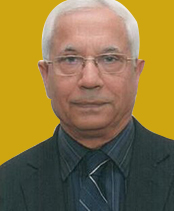Programs
- M. Tech. in Automotive Engineering -Postgraduate
- B.Sc. (Honours) in Microbiology and lntegrated Systems Biology -

Sr Professor, Disaster Management, Indian Institute of Public Administration
Talk Title: Science Technology and Innovation for Climate Resilience and Disaster Risk Reduction
Professor Vinod Kumar Sharma (M.Sc. Botany, PGDip. Resources Ecology, Ph.D. Forest Ecology, B.H.U.) Senior Professor, Disaster Management/Consultant at Indian Institute of Public Administration; Vice Chairman, Sikkim State Disaster Management Authority, Govt. of Sikkim. He was member of UN ISDR ASTAAG (Asia Science and Technology Academic Advisory Group from 2015-2019). Member committee for framing National Science, Technology and Innovation Policy 2020 of Govt. Of India (Chairman Sub Group on Capacity Development).Prof Sharma is Adjuct Professor at Amrita University and Advisor and Board of Studies of Amrita School of Sustainable Future. He is Visiting Professor, Kyoto University, Japan. Prof. Sharma is nominated as Senior Advisor of Coalition for Disaster Resilient Infrastructure (CDRI) for 2025-2027.
He is the recipient of Subhash Chandra Bose Aapda Prabandhan National Award 2022 , and Paul Appleby Award for Public Administration 2017 .
Professor Sharma started his career from Meerut University and served in a number of Universities in India, Middle East and USA before joining the Indian Institute of Public Administration in 1992. He was instrumental in setting up National Centre for Disaster Management at IIPA which is now National Institute of Disaster Management under Ministry of Home, Govt. of India. Prof. Sharma was Chairman SEEDS India from 1995-2020. He is member of executive committee of Sphere India (a network of NGOs and UN organizations working in disaster management). He has published more than 100 research papers and 20 books in area of Environment and disaster management. He is also member of several important committees of NDMA/NIDM.
In the face of escalating climate change and the increasing frequency of natural disasters, science, technology, and innovation (STI) have emerged as crucial enablers of climate resilience and disaster risk reduction. As countries strive to meet sustainable development goals amidst environmental uncertainty, it is essential to adopt a forward-looking, multi-dimensional approach that integrates scientific knowledge with innovative practices. Technological solutions underpinned by robust data and research are playing a transformative role in adapting to climate-induced disruptions, especially in critical sectors like agriculture, water resources, and energy systems. Innovations such as climate-smart agriculture, green infrastructure, renewable energy technologies, and nature-based solutions are reshaping the way communities prepare for, respond to, and recover from climate events. These approaches not only reduce vulnerability but also offer co-benefits like biodiversity conservation, improved air quality, and carbon sequestration.
Integrating data analytics and scientific modeling into planning frameworks enables evidence- based decision-making, ensuring targeted and timely interventions. For instance, the use of real-time climate data and geospatial analysis has proven instrumental in urban flood management, where predictive tools guide infrastructure development and community alerts, minimizing loss and damage. However, several challenges persist, including institutional constraints, lack of technical capacity, and limited access to resources, especially in vulnerable regions.
India’s sustainable development vision emphasizes self-reliance by promoting indigenous knowledge systems, nurturing grassroots innovations, and investing in homegrown technologies. To fully realize the potential of STI in climate adaptation, India must prioritize investments in research and development, strengthen inter-sectoral collaboration, and institutionalize knowledge-sharing platforms. Importantly, aligning these efforts with the vision of Atmanirbhar Bharat, a self-reliant India, can significantly enhance climate resilience by fostering indigenous technologies, empowering local communities, and reducing dependence on external solutions. By integrating traditional knowledge with modern scientific approaches, and encouraging homegrown innovation, Atmanirbhar Bharat offers a framework for scalable, culturally rooted, and economically viable climate solutions. Bridging the gap between innovation and real-world application through inclusive policies and continuous learning will not only build resilience but also reinforce India’s commitment to sustainable development and long- term climate security.
India’s four global initiatives-International Solar Alliance, International Big Cat Alliance, Coalition of Disaster Resilient Infrastructure (CDRI) and Mission LiFE (LiFE style for Environment) are important steps towards sustainability.